Towards Improved Humidity Sensing Nanomaterials via Combined Electron and NH3 Treatment of Carbon-Rich FEBID Deposits
Abstract
1. Introduction
2. Materials and Methods
2.1. Chemicals
2.2. UHV Setup
2.3. Deposit Preparation, Thermal Desorption Spectrometry (TDS), and Electron-Stimulated Desorption (ESD)
2.4. Auger Electron Spectroscopy (AES)
2.5. Reflection Absorption Infrared Spectroscopy (RAIRS)
3. Results
3.1. General Procedures
3.2. Preparation and Characterization of Carbonaceous Deposits
3.3. Incorporation of Nitrogen in the Deposits and Effect on Binding of H2O
4. Discussion
5. Conclusions
Supplementary Materials
Author Contributions
Funding
Institutional Review Board Statement
Informed Consent Statement
Data Availability Statement
Conflicts of Interest
References
- Utke, I.; Hoffmann, P.; Melngailis, J. Gas-assisted focused electron beam and ion beam processing and fabrication. J. Vac. Sci. Technol. B Microelectron. Nanometer Struct. 2008, 26, 1197. [Google Scholar] [CrossRef]
- Huth, M.; Porrati, F.; Schwalb, C.; Winhold, M.; Sachser, R.; Dukic, M.; Adams, J.; Fantner, G. Focused electron beam induced deposition: A perspective. Beilstein J. Nanotechnol. 2012, 3, 597–619. [Google Scholar] [CrossRef] [PubMed]
- Botman, A.; Mulders, J.J.L.; Hagen, C.W. Creating pure nanostructures from electron-beam-induced deposition using purification techniques: A technology perspective. Nanotechnology 2009, 20, 372001. [Google Scholar] [CrossRef] [PubMed]
- Kolb, F.; Schmoltner, K.; Huth, M.; Hohenau, A.; Krenn, J.; Klug, A.; List, E.J.W.; Plank, H. Variable tunneling barriers in FEBID based PtC metal-matrix nanocomposites as a transducing element for humidity sensing. Nanotechnology 2013, 24, 305501. [Google Scholar] [CrossRef]
- Dukic, M.; Winhold, M.; Schwalb, C.H.; Adams, J.D.; Stavrov, V.; Huth, M.; Fantner, G.E. Direct-write nanoscale printing of nanogranular tunnelling strain sensors for sub-micrometre cantilevers. Nat. Commun. 2016, 7, 12487. [Google Scholar] [CrossRef]
- Zhang, J.; Gai, M.; Ignatov, A.V.; Dyakov, S.A.; Wang, J.; Gippius, N.A.; Frueh, J.; Sukhorukov, G.B. Stimuli-Responsive Microarray Films for Real-Time Sensing of Surrounding Media, Temperature, and Solution Properties via Diffraction Patterns. ACS Appl. Mater. Interfaces 2020, 12, 19080–19091. [Google Scholar] [CrossRef]
- Clemens, A.; Hellberg, L.; Grönbeck, H.; Chakarov, D. Water desorption from nanostructured graphite surfaces. Phys. Chem. Chem. Phys. 2013, 15, 20456–20462. [Google Scholar] [CrossRef]
- Bolina, A.S.; Wolff, A.J.; Brown, W.A. Reflection absorption infrared spectroscopy and temperature-programmed desorption studies of the adsorption and desorption of amorphous and crystalline water on a graphite surface. J. Phys. Chem. B 2005, 109, 16836–16845. [Google Scholar] [CrossRef][Green Version]
- Chakarov, D.V.; Österlund, L.; Kasemo, B. Water adsorption on graphite (0001). Vacuum 1995, 46, 1109–1112. [Google Scholar] [CrossRef]
- Rohdenburg, M.; Fröch, J.E.; Martinović, P.; Lobo, C.J.; Swiderek, P. Combined Ammonia and Electron Processing of a Carbon-Rich Ruthenium Nanomaterial Fabricated by Electron-Induced Deposition. Micromachines 2020, 11, 769. [Google Scholar] [CrossRef]
- Tamura, N.; Aono, M.; Abe, H.; Kitazawa, N.; Watanabe, Y. Electrical resistivity response of amorphous carbon nitride thin films in various gas atmospheres. Jpn. J. Appl. Phys. 2015, 54, 41401. [Google Scholar] [CrossRef]
- Rohdenburg, M.; Winkler, R.; Kuhness, D.; Plank, H.; Swiderek, P. Water-Assisted Process for Purification of Ruthenium Nanomaterial Fabricated by Electron Beam Induced Deposition. ACS Appl. Nano Mater. 2020, 3, 8352–8364. [Google Scholar] [CrossRef]
- Rohdenburg, M.; Boeckers, H.; Brewer, C.R.; McElwee-White, L.; Swiderek, P. Efficient NH3-based process to remove chlorine from electron beam deposited ruthenium produced from (\eta3-C3H5)Ru(CO)3Cl. Sci. Rep. 2020, 10, 10901. [Google Scholar] [CrossRef] [PubMed]
- Good, W.D.; Smith, N.K. The enthalpies of combustion of the isomeric pentenes in the liquid state. A warning to combustion calorimetrists about sample drying. J. Chem. Thermodyn. 1979, 11, 111–118. [Google Scholar] [CrossRef]
- Ramos-Estrada, M.; Iglesias-Silva, G.A.; Hall, K.R. Experimental measurements and prediction of liquid densities for n-alkane mixtures. J. Chem. Thermodyn. 2006, 38, 337–347. [Google Scholar] [CrossRef]
- Wnuk, J.D.; Gorham, J.M.; Rosenberg, S.G.; van Dorp, W.F.; Madey, T.E.; Hagen, C.W.; Fairbrother, D.H. Electron Induced Surface Reactions of the Organometallic Precursor Trimethyl(methylcyclopentadienyl)platinum(IV). J. Phys. Chem. C 2009, 113, 2487–2496. [Google Scholar] [CrossRef]
- Briggs, D.; Grant, J.T. (Eds.) Surface Analysis by Auger and X-ray Photoelectron Spectroscopy; SurfaceSpectra: Manchester, UK, 2003; ISBN 1901019047. [Google Scholar]
- Cumpson, P.J.; Seah, M.P. Elastic Scattering Corrections in AES and XPS. II. Estimating Attenuation Lengths and Conditions Required for their Valid Use in Overlayer/Substrate Experiments. Surf. Interface Anal. 1997, 25, 430–446. [Google Scholar] [CrossRef]
- Manzanares, I.C.; Blunt, V.M.; Peng, J. Spectroscopy of C-H stretching vibrations of gas-phase butenes: Cis-2-butene, trans-2-butene, 2-methyl-2-butene, and 2,3-dimethyl-2-butene. J. Phys. Chem. 1993, 97, 3994–4003. [Google Scholar] [CrossRef]
- Peng, J.; Mina-Camilde, N.; Manzanares, I.C. Infrared spectroscopy of 2-methyl-2-butene in liquid argon solution and ab initio calculated vibrational frequencies. Vib. Spectrosc. 1995, 8, 319–329. [Google Scholar] [CrossRef]
- Soto, G.; de La Cruz, W.; Farías, M.H. XPS, AES, and EELS characterization of nitrogen-containing thin films. J. Electron Spectrosc. Relat. Phenom. 2004, 135, 27–39. [Google Scholar] [CrossRef]
- Warneke, Z.; Rohdenburg, M.; Warneke, J.; Kopyra, J.; Swiderek, P. Electron-driven and thermal chemistry during water-assisted purification of platinum nanomaterials generated by electron beam induced deposition. Beilstein J. Nanotechnol. 2018, 9, 77–90. [Google Scholar] [CrossRef]
- Böhler, E.; Warneke, J.; Swiderek, P. Control of chemical reactions and synthesis by low-energy electrons. Chem. Soc. Rev. 2013, 42, 9219–9231. [Google Scholar] [CrossRef] [PubMed]
- Huels, M.A.; Dugal, P.-C.; Sanche, L. Degradation of functionalized alkanethiolate monolayers by 0–18 eV electrons. J. Chem. Phys. 2003, 118, 11168–11178. [Google Scholar] [CrossRef]
- Turchanin, A.; Gölzhäuser, A. Carbon nanomembranes from self-assembled monolayers: Functional surfaces without bulk. Prog. Surf. Sci. 2012, 87, 108–162. [Google Scholar] [CrossRef]
- Zharnikov, M.; Geyer, W.; Gölzhäuser, A.; Frey, S.; Grunze, M. Modification of alkanethiolate monolayers on Au-substrate by low energy electron irradiation: Alkyl chains and the S/Au interface. Phys. Chem. Chem. Phys. 1999, 1, 3163–3171. [Google Scholar] [CrossRef]
- Utke, I.; Swiderek, P.; Höflich, K.; Madajska, K.; Jurczyk, J.; Martinović, P.; Szymańska, I.B. Coordination and organometallic precursors of group 10 and 11: Focused electron beam induced deposition of metals and insight gained from chemical vapour deposition, atomic layer deposition, and fundamental surface and gas phase studies. Coord. Chem. Rev. 2022, 458, 213851. [Google Scholar] [CrossRef]
- Davies, A.G. Photolytic reactions of cyclopentadienylmetallic compounds. Pure Appl. Chem. 1982, 54, 23–28. [Google Scholar] [CrossRef]
- Ouchi, A.; Tsunoda, T.; Bastl, Z.; Maryško, M.; Vorlíček, V.; Boháček, J.; Vacek, K.; Pola, J. Solution photolysis of ferrocene into Fe-based nanoparticles. J. Photochem. Photobiol. A Chem. 2005, 171, 251–256. [Google Scholar] [CrossRef]
- Elihn, K.; Landström, L.; Alm, O.; Boman, M.; Heszler, P. Size and structure of nanoparticles formed via ultraviolet photolysis of ferrocene. J. Appl. Phys. 2007, 101, 34311. [Google Scholar] [CrossRef]
- Baroncelli, M.; Mao, Q.; Galle, S.; Hansen, N.; Pitsch, H. Role of ring-enlargement reactions in the formation of aromatic hydrocarbons. Phys. Chem. Chem. Phys. 2020, 22, 4699–4714. [Google Scholar] [CrossRef]
- Kaiser, R.I.; Zhao, L.; Lu, W.; Ahmed, M.; Zagidullin, M.V.; Azyazov, V.N.; Mebel, A.M. Formation of Benzene and Naphthalene through Cyclopentadienyl-Mediated Radical-Radical Reactions. J. Phys. Chem. Lett. 2022, 13, 208–213. [Google Scholar] [CrossRef] [PubMed]
- Mao, Q.; Huang, C.; Baroncelli, M.; Shen, L.; Cai, L.; Leonhard, K.; Pitsch, H. Unimolecular reactions of the resonance-stabilized cyclopentadienyl radicals and their role in the polycyclic aromatic hydrocarbon formation. Proc. Combust. Inst. 2021, 38, 729–737. [Google Scholar] [CrossRef]
- Stohmann, P.; Koch, S.; Yang, Y.; Kaiser, C.D.; Ehrens, J.; Schnack, J.; Biere, N.; Anselmetti, D.; Gölzhäuser, A.; Zhang, X. Investigation of electron-induced cross-linking of self-assembled monolayers by scanning tunneling microscopy. Beilstein J. Nanotechnol. 2022, 13, 462–471. [Google Scholar] [CrossRef]
- Schmidt, F.; Borrmann, T.; Mues, M.P.; Benter, S.; Swiderek, P.; Bredehöft, J.H. Mechanisms of Electron-Induced Chemistry in Molecular Ices. Atoms 2022, 10, 25. [Google Scholar] [CrossRef]
- Böhler, E.; Bredehöft, J.H.; Swiderek, P. Low-Energy Electron-Induced Hydroamination Reactions between Different Amines and Olefins. J. Phys. Chem. C 2014, 118, 6922–6933. [Google Scholar] [CrossRef]
- Hamann, T.; Böhler, E.; Swiderek, P. Low-Energy-Electron-Induced Hydroamination of an Alkene. Angew. Chem. Int. Ed. 2009, 48, 4643–4645. [Google Scholar] [CrossRef] [PubMed]
- Rawat, P.; Prabhudesai, V.S.; Rahman, M.A.; Ram, N.B.; Krishnakumar, E. Absolute cross sections for dissociative electron attachment to NH3 and CH4. Int. J. Mass Spectrom. 2008, 277, 96–102. [Google Scholar] [CrossRef]
- Siddique, K.; Altarawneh, M.; Saeed, A.; Zeng, Z.; Gore, J.; Dlugogorski, B.Z. Interaction of NH2 radical with alkylbenzenes. Combust. Flame 2019, 200, 85–96. [Google Scholar] [CrossRef]
- Yuzawa, H.; Kumagai, J.; Yoshida, H. Reaction Mechanism of Aromatic Ring Amination of Benzene and Substituted Benzenes by Aqueous Ammonia over Platinum-Loaded Titanium Oxide Photocatalyst. J. Phys. Chem. C 2013, 117, 11047–11058. [Google Scholar] [CrossRef]
- Rohdenburg, M.; Martinović, P.; Ahlenhoff, K.; Koch, S.; Emmrich, D.; Gölzhäuser, A.; Swiderek, P. Cisplatin as a Potential Platinum Focused Electron Beam Induced Deposition Precursor: NH3 Ligands Enhance the Electron-Induced Removal of Chlorine. J. Phys. Chem. C 2019, 123, 21774–21787. [Google Scholar] [CrossRef]
- Warneke, J.; Rohdenburg, M.; Zhang, Y.; Orszagh, J.; Vaz, A.; Utke, I.; de Hosson, J.T.M.; van Dorp, W.F.; Swiderek, P. Role of NH3 in the Electron-Induced Reactions of Adsorbed and Solid Cisplatin. J. Phys. Chem. C 2016, 120, 4112–4120. [Google Scholar] [CrossRef]
- Laskin, J.; Johnson, G.E.; Warneke, J.; Prabhakaran, V. From Isolated Ions to Multilayer Functional Materials Using Ion Soft Landing. Angew. Chem. Int. Ed. 2018, 57, 16270–16284. [Google Scholar] [CrossRef] [PubMed]
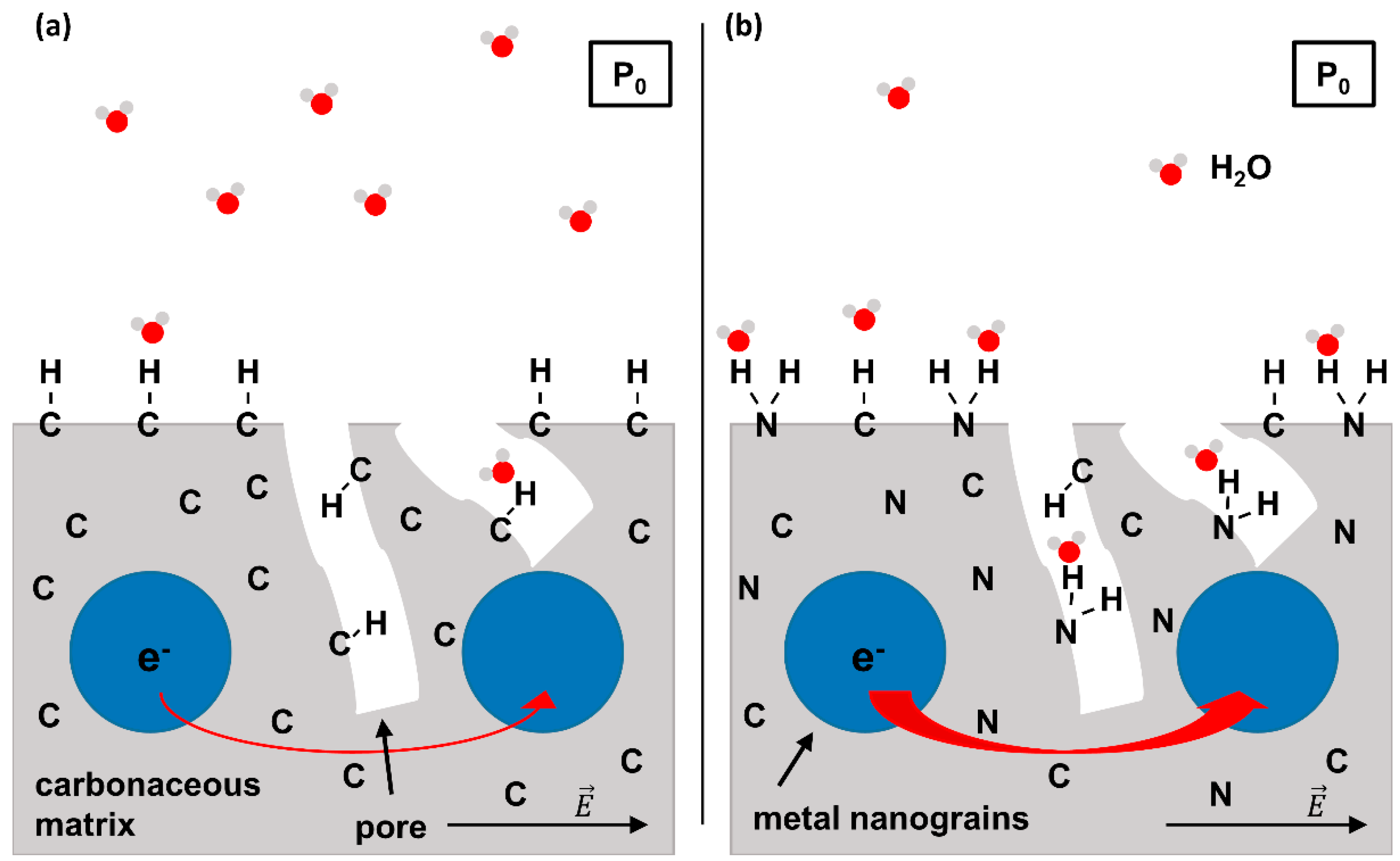


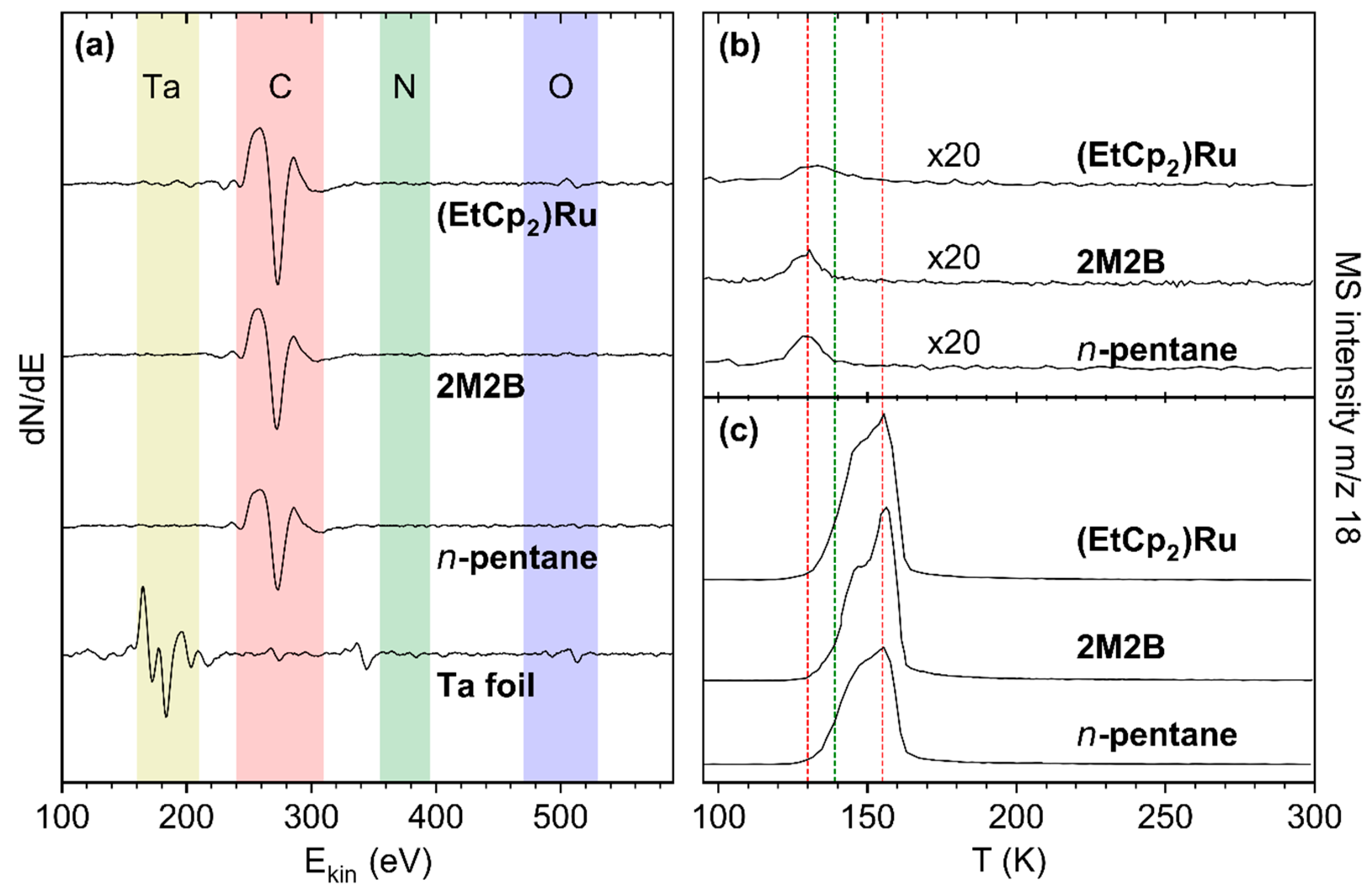
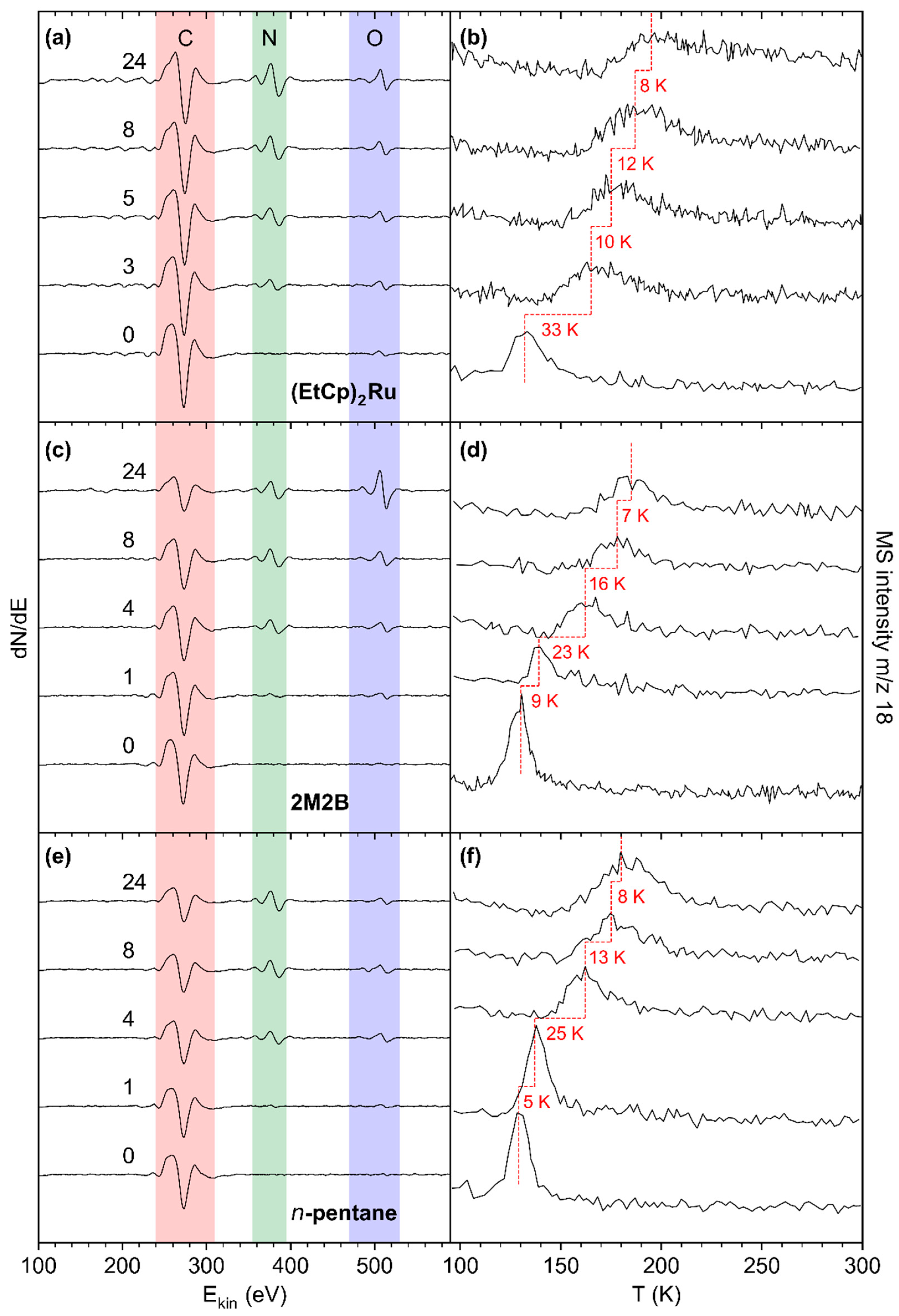
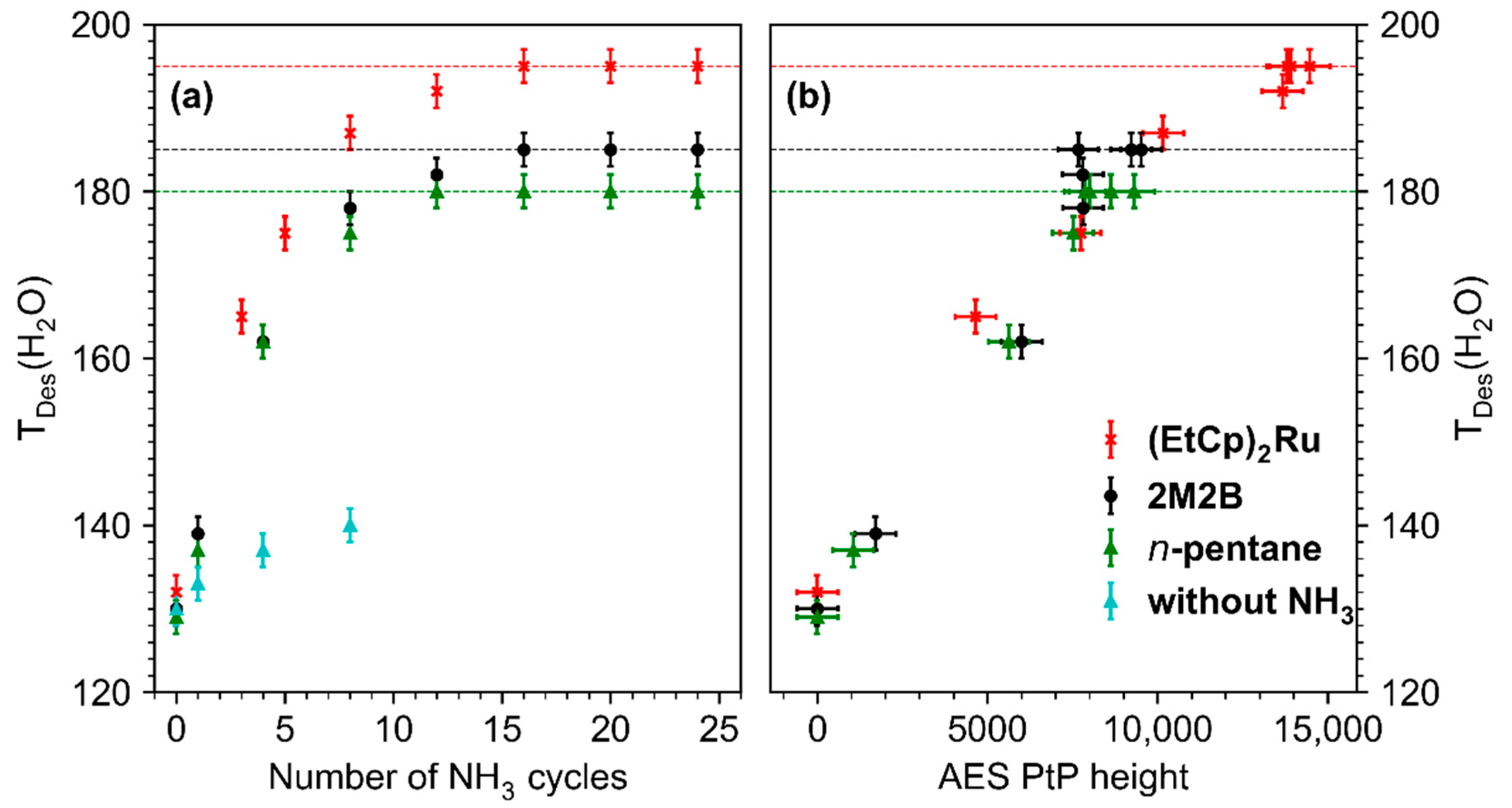

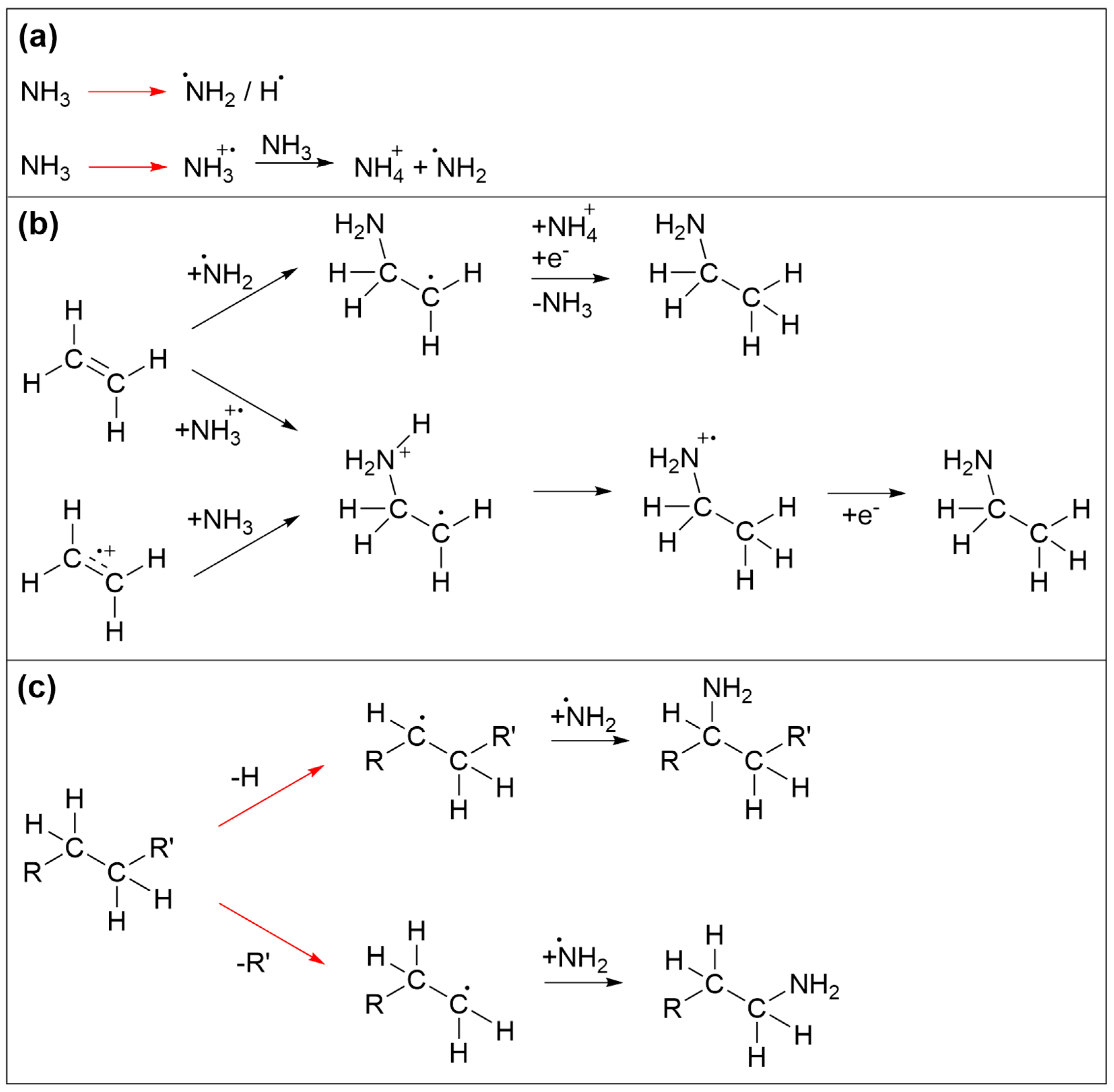
Publisher’s Note: MDPI stays neutral with regard to jurisdictional claims in published maps and institutional affiliations. |
© 2022 by the authors. Licensee MDPI, Basel, Switzerland. This article is an open access article distributed under the terms and conditions of the Creative Commons Attribution (CC BY) license (https://creativecommons.org/licenses/by/4.0/).
Share and Cite
Boeckers, H.; Swiderek, P.; Rohdenburg, M. Towards Improved Humidity Sensing Nanomaterials via Combined Electron and NH3 Treatment of Carbon-Rich FEBID Deposits. Nanomaterials 2022, 12, 4455. https://doi.org/10.3390/nano12244455
Boeckers H, Swiderek P, Rohdenburg M. Towards Improved Humidity Sensing Nanomaterials via Combined Electron and NH3 Treatment of Carbon-Rich FEBID Deposits. Nanomaterials. 2022; 12(24):4455. https://doi.org/10.3390/nano12244455
Chicago/Turabian StyleBoeckers, Hannah, Petra Swiderek, and Markus Rohdenburg. 2022. "Towards Improved Humidity Sensing Nanomaterials via Combined Electron and NH3 Treatment of Carbon-Rich FEBID Deposits" Nanomaterials 12, no. 24: 4455. https://doi.org/10.3390/nano12244455
APA StyleBoeckers, H., Swiderek, P., & Rohdenburg, M. (2022). Towards Improved Humidity Sensing Nanomaterials via Combined Electron and NH3 Treatment of Carbon-Rich FEBID Deposits. Nanomaterials, 12(24), 4455. https://doi.org/10.3390/nano12244455





